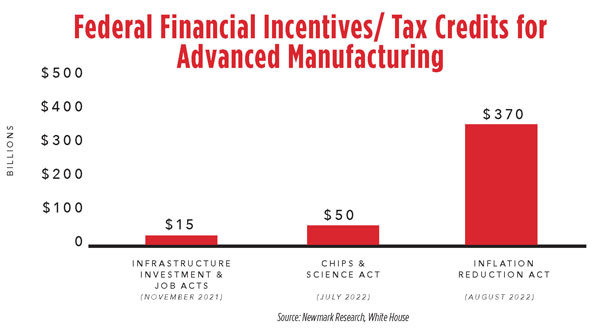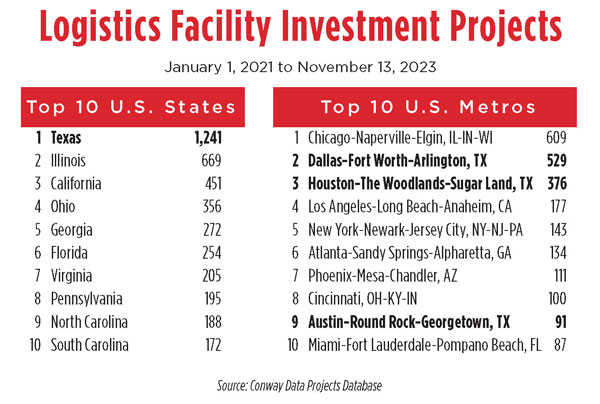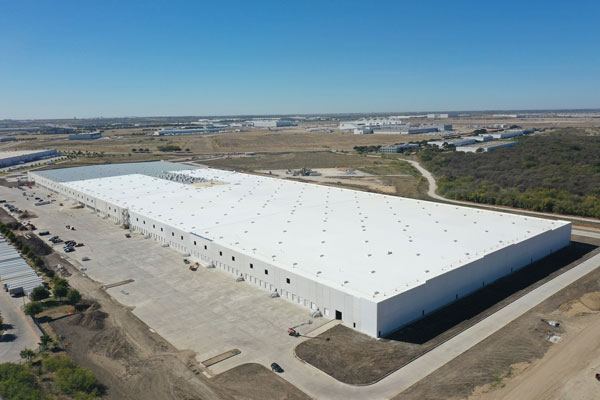Trade tensions between the U.S. and China and the rising costs of Chinese labor were already established headwinds to the global supply chain status-quo at the onset of the pandemic in 2020. The ensuing two years of turbulence revealed the fragility of the global supply chain. The shifting landscape has led to a resurgence of government-led industrial policy and an effort to diversify and strengthen supply chains. Many firms are acting to bring production closer to consumption through reshoring, nearshoring, foreign direct investment and domestic expansion, according to Newmark’s 2024 Manufacturing Momentum Thought Leadership Series.
Indicators all signal that industrial demand will swing to the upside in the short term. Warehouses are still at maximum capacity as inventories have ballooned. Imports remain historically high and supply chain woes have not fully eased. Investment in new manufacturing facilities is on the rise fueled by the Inflation Reduction Act and the CHIPS and Science Act. These three federal funding programs are predicted to furnish anywhere from 15% to 50% of costs for some manufacturing projects.
Where Is This Growth Happening?
Arizona and Texas lead in investment, with a combined $120 billion, and Texas, Georgia and North Carolina all lead the country in sheer numbers of major manufacturing announcements.

Texas is a state poised for a strong recovery overall. Despite recent rises in interest rates having a negative impact on the overall market, and investment volume dropping, companies continue to relocate to Texas.
Texas was the No. 1 state for logistics facility investment, with Dallas/Ft. Worth, Houston, and Austin all being in the Top 10 U.S. metros for investment.
An example of Texas’ strong growth is DrinkPAK, whose two DFW-area leases represented the largest new industrial tenant leases completed in the U.S. in 2023.

DrinkPAK North Texas will ultimately produce about 4% to 5% of all cans in North America, as DrinkPak has contracts with about every major energy drink company, beer and canned-spirits company, major canned-water companies, and most of the major non-soda brands.
DrinkPak’s two leases totaled 3 million sq. ft. of Ft. Worth industrial space and Ft. Worth approved a 10-year tax abatement valued at $21 million for DrinkPAK’s estimated $452 million investment in developing advanced manufacturing assets for the production, warehousing and distribution of various beverages. The company is projected to create 1,000 full-time jobs in the area by 2026, with an average annual salary of about $70,000.
DrinkPak CEO Nate Patena told CEO Magazine that he “expects the sites to more than double the brand’s manufacturing output. In the many other cities we searched, we would be getting the same footprint in five, six or seven buildings. They were not in close geographic proximity, and finding contiguous square footage was an absolute must in our business because we handle and produce 4,000 to 5,000 pallets a day.”
At the southern end of the state is Kinimatic, a U.S.-based warehousing and fulfillment service platform that announced the strategic expansion of its national network with the addition of 1.6 million sq. ft. of premium warehouse space in 14 locations between Laredo and Pharr on the southern Texas border.
“The total Kinimatic footprint in Texas will be close to 5 million square feet in combination with our other Texas-based facilities. Meeting the demand for cross-border logistics solutions is an important development that serves our customers’ inbound freight needs and allows Kinimatic to provide not only warehousing, but high-velocity transload solutions, upwards of 400 per day if necessary,” said Mike Shaw, COO at Kinimatic.
US-Mexico Nearshoring Logistics Solutions
An analysis conducted by Newmark Mexico Research determined that nearshoring directly drove more than 13 million sq. ft. in Mexican industrial markets — a significant portion of its overall annual industrial absorption.
This figure is expected to rise even further, on the heels of announcements made thus far in 2023, such as Tesla’s $10 billion gigafactory in Monterrey.
For the first time since 2002, the total annual imports from Mexico exceeded the total from China, reiterating the trend toward bringing manufacturing closer to the U.S. For years, America’s top trading partner has been China, but China is now falling behind because of recent controversies, trade policies and frictions. Mexico has been creeping up gradually for much of the last decade, and now it’s finally surpassed China.
The global disruptions caused by the pandemic led to many supply-chain and trade disruptions, especially internationally, and exposed the global overreliance on distant manufacturing centers, particularly in Asia. Disruptions to airports, ports and shipping worldwide drove the cost of international shipping and transit times sky-high.
To prevent this from happening again, many companies have been tackling their overreliance on international trade by looking to bring production closer. This is where Mexico’s proximity to Texas, coupled with its agility in responding to market demands, has positioned it as a resilient and strategic alternative.
But there are challenges. In other regions of the world such as Southeast Asia, various skill levels and wages exist across nearby countries that are mostly friendly toward each other. Think Singapore for high-skilled, Indonesia for medium-skilled, and Laos for low-skilled jobs. This makes setting up localized manufacturing ecosystems easier, as the proper jobs go to the proper areas.
But when you add Texas and northern Mexico together, there is only some of the synergy needed for robust manufacturing facilities, where some jobs are more basic and others more skilled. It’s not a complete answer, and northern Mexico seems poised to run out of manufacturing workers soon, given the explosion in facilities in Mexico that have cropped up in recent years.
Eventually Nearshoring Will Impact All CRE
Nearshoring has the potential to profoundly impact all types of commercial real estate in markets all over the country. Ongoing supply chain changes of this magnitude could influence where jobs are created and that would influence space demand for all types of real estate, housing, self-storage, retail and almost every other type.
 DrinkPak’s 1.5 million-sq.-ft. manufacturing facility on Eagle Parkway in Fort Worth.
DrinkPak’s 1.5 million-sq.-ft. manufacturing facility on Eagle Parkway in Fort Worth.
Photo courtesy of DrinkPak
Rising shipping container costs and insurance rates are also having a big impact. Because of geopolitical conflict in the region, reduced shipping through the Suez and Panama Canals has put upward pressure on shipping costs, and that trend has continued.
The cost to move a container from China to the U.S. West Coast has increased from about $1,700 in Dec 2023 to $4,800 per container in Feb 2024. Shipping a container from China to the U.S. East Coast is even higher. It was about $6,700 in February, up by almost $4,200 since December.
Insurance costs for ships navigating the Red Sea have increased by 600% to 900% in the past two months, and businesses are adding that math into their equations.
As a viable option, Canada and Mexico are prime options for companies to move their manufacturing closer to the U.S. Not only is putting cargo onto a truck or train and driving it to the U.S. a lot cheaper than shipping it halfway around the world, but more importantly, supply chain resiliency and reliability may make the investment worthwhile.
